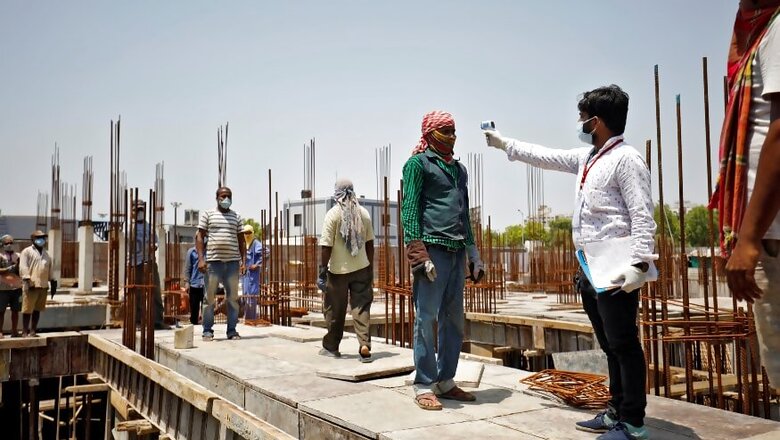
views
One of the first changes that came in the city folks’ lives in India after the COVID-19 induced lockdown kicked in was the sudden absence of their domestic helps. The impact was immediate, and abrupt. As the country was confined to their homes, urban families were forced to carry out their household chores that was often taken as a given.
After six weeks when the government eased some rules allowing gradual resumption of economic activity, one of the most-asked questions, perhaps, has been: Can my house help and driver come for work? Many were also, possibly, trying to find out whether AC mechanics, carpenters or plumbers would be allowed to come in.
The lockdown of kind that India, and many other countries have imposed, is akin to a medically induced coma. Doctors sometimes choose to black out a patient as an accepted line of treatment. The return to normalisation, however, follows a strict medically dictated step-by-step protocol.
The lockdown’s effect has been very similar. Restrictions are being lifted, but progressively. Factories that have remained shut can now restart work, but conditions apply. Construction activity that were ordered shut overnight because areas with large gatherings were to be emptied out, can now resume work under certain conditions.
Domestic helps, carpenters, electricians, AC and car mechanics and all such self-employed service providers can also return to work, if local resident associations agree to let them in their areas. People have also been allowed to order food and other products on e-commerce platforms, and cab aggregators can resume services in several areas.
These are gingerly taken, tentative steps towards rebooting the Indian economy, which until recently, was an engine for global growth and had set its sights on the turning in with USD 5 trillion GDP in a few years from now.
A key characteristic of the Indian economy is the services sector’s influence in both depth and breadth. The services sector accounts for nearly two-thirds of India’s economy.
And it is not just about the storied software companies that have fuelled aspirations and prosperity among the middle-class. The Indian services sector is also as much about those who have moved hundreds of kilometers from their villages to eke out a living beneath cityscapes as roadside tea vendors, vegetable sellers, newspaper hawkers, domestic helps, drivers, cobblers and construction workers.
Of India’s workforce, 90 percent is in the informal sector, millions of whom have migrated from their villages in search of a better living. In terms of sheer numbers, these inter-state migrants make up for a colossal magnitude, underlining their importance in India’s economic structure.
The Census 2011 pegs the total number of internal migrants in the country (accounting for inter- and intra-state movement) at a staggering 139 million.
Uttar Pradesh and Bihar are the biggest source states, followed closely by Madhya Pradesh, Punjab, Rajasthan, Uttarakhand, Jammu and Kashmir and West Bengal; the major destination states are Delhi, Maharashtra, Tamil Nadu, Gujarat, Andhra Pradesh and Kerala.
The Economic Survey of 2017 gives a fascinating insight into India’s internal migration. It used monthly data on unreserved railway passenger traffic between every pair of stations in India for the years 2011-2016.
The key idea was to use net annual flows of unreserved passenger travel as a proxy for work-related migrant flow. This class of travel serves less affluent people, who are more likely to travel for work-related reasons.
It is also relatively unconstrained by capacity, hence, reflecting the demand for travel, whereas reserved passenger traffic is more likely to be constrained by the supply of seats. That data shows that such migration within India is between 5 and 9 million annually.
This may have accelerated in recent years with higher growth in the construction sector and a host of economic opportunities as more areas get urbanised.
This has also spawned a bustling domestic remittances market, estimated to exceed Rs. 1.5 lakh crore annually. Effectively, this implies that migrants working in urban areas are sending money back to their families in villages worth two-and-half-times the annual NREGA budget.
These money transfers, from migrant labourers to villages, serve 10 percent of households in rural India and finance over 30 percent of household consumption in remittance-receiving households, buttressing the importance of urban growth for rural families.
The movement of migrant workers back to their villages need to be seen in this context. As the domestic remittances estimates, it could well be economically rewarding if they managed to get back to work in the cities and towns that they were engaged in before the lockdown.
The Centre, to be sure, have sought to help these people stay put in their current places through welfare measures.
On March 26, 2020, Finance Minister Nirmala Sitharaman rolled out a Rs 1.7 lakh-crore relief package, in an attempt to limit the economic damage caused by the coronavirus outbreak and tackle the loss of livelihood of millions of poor hit by the lockdown.
The relief package, under a newly framed Prime Minister Garib Kalyan Yojana, aims to alleviate the financial pain faced by migrant workers, farmers, urban and rural poor and women.
About 800 million people will get 5kg of wheat or rice each month for three months for free, over and above the 5kg they already get.
A one-time transfer of Rs 500 per month for next three months to the Jan Dhan accounts of 200 million women will be made, of which Rs 10,000 crore has already been deposited. Women of 83 million BPL families have also been provided free cooking gas cylinders for three months under the Ujjwala scheme.
Collateral-free loans provided to women self-help groups have also been doubled to Rs 20 lakh for 6.3 million such groups, which will benefit 70 million households.
The government is also bearing the cost of the provident fund contributions, both of the employer and employees—12 percent each—until June, which have up to 100 employees and 90 percent of whom are earning less than Rs 15,000 per month as salary. More than 4.1 million people have benefited from this with government transferring about Rs 35,000 crore into the EPFO corpus.
Provident fund scheme regulation have also been amended to allow non-refundable advance of 75 percent from the provident fund for contingency expenditure or three months of wages whichever is lower. Until now, 8.72 lakh people have availed this benefit, withdrawing more than Rs 2,700 crore.
The central government has also directed state governments to use the existing welfare fund with Rs 34,000 crore reserves to provide assistance to 21 million construction workers to protect them from economic disruption.
The role of migrant workers in India’s economic rebirth cannot be overemphasised. The jostle to return home in the wake of uncertainty, and no work in sight, is obvious. But, their prospects could well be better staying put in the cities, if appropriate welfare measures reach them. Factories, construction sites and the informal gig and service economy in towns and cities are critical both to the migrant worker as well as the broader economy.




















Comments
0 comment